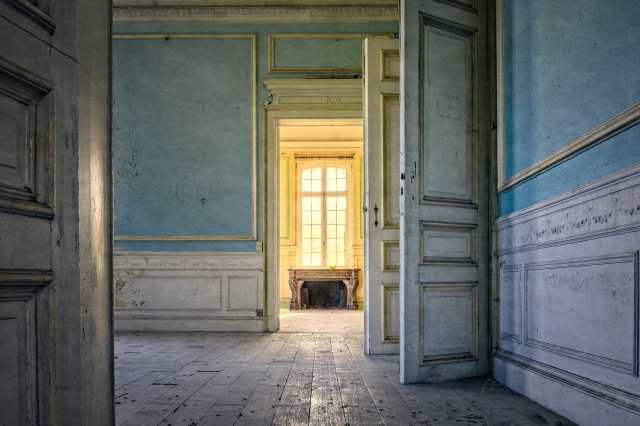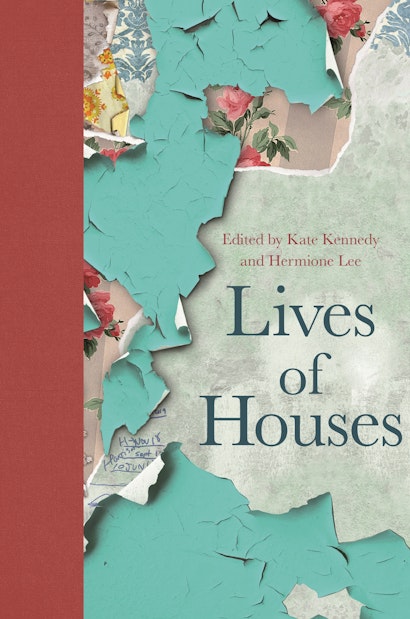The writing of lives often involves writing about houses. Bringing a house to life through observation, familiarity, memory, or excavation can be a vital part of narrating the life of an individual, a family, or a group: life-writing as housework. A house can embody a person’s childhood, the story of a marriage, an inherited way of life, or a national history. The constructing of a house can be the fulcrum of dreams, ambitions, illusions, and pretensions. How a house is lived in can tell you everything you need to know about people, whether it’s the choice of wallpaper, the mess in the kitchen, the silence or shouting over meals, doors left open or closed, a fire burning in the hearth. The loss of a house can be a turning point that shapes the rest of a life.
Memoirs or autobiographies often start with the memory of a house. One of Virginia Woolf’s first memories was of waking up as a child in the nursery of Talland House in Cornwall, her family’s summer home. From that first memory she reconstructs, through colours and sounds and rhythms and fragments, the life they lived in that house, inseparable from her emotions about it. Henry James, setting out on his minutely recalled, fine-tuned, late-life autobiography, opens the book of his life with his faint, glimmering memory of his grandmother’s house in Albany, and her reading in it, holding her book out at a distance by the light of a single candle. Eudora Welty, telling the story of what made her a writer, begins with her description of her family house, where, at the time of writing, she still lived, eighty years on: “In our house on North Congress Street in Jackson, Mississippi, where I was born, the oldest of three children, in 1909, we grew up to the striking of clocks.” The life of a house is, also, a story of time.
Some life-stories—and these can be told in poems, plays, and novels, as well as autobiographies and biographies—are fixed inside one overpowering house, a house that can’t be escaped from. Some make their story turn on the moment that a beloved old house has to be left. Some build their life-story on memories, which often include memories of houses, or they imagine the house of troubled inhabitants as a kind of haunted house. Hilary Mantel starts her autobiography, Giving Up the Ghost, on the day she and her husband have decided to sell their second home, a Norfolk cottage where her mother and her late stepfather often came to stay. Looking up, she sees the air move, and she knows it is her stepfather’s ghost coming down the staircase. This does not “perturb” her. She often thinks in terms of haunted houses. Every house you live in involves other, abandoned choices, roads not taken, ghosts from the past. “All your houses are haunted by the person you might have been.”
That tremor in the air, which reminds you that solid bricks-and-mortar can also be unstable, and that the lives of houses, like everything we know, must pass, is often built into the narratives of houses. Long after the family had left it, Woolf turned Talland House into fiction in To the Lighthouse, and imagines the moment when the long-deserted house might just tip over into becoming a ruin, as houses easily can:
The house was left, the house was deserted. It was left like a shell on a sandhill to fill with dry salt grains now that life had left it. . . . One feather, and the house, sinking, falling, would have turned and pitched downwards to the depths of darkness.
Robert Frost’s haunting poem “Directive” takes you on a journey looking for traces of a house that disappeared long ago and has fallen back into a remote, neglected New England landscape. It is now “a house that is no more a house.” Yet it might be a place where, in your imagination, you could “make yourself at home.”
“House” and “home” notoriously make awkward neighbours. Sometimes the words invite each other in; sometimes they won’t give each other the time of day. Dictionaries and books of proverbs and old sayings tell you different things. We all know that “a house is not a home” (was it Benjamin Franklin who first coined this useful cliché?), and we are often told so, whether in hokey popular sayings (“It takes a heap of living to make a house a home”) or lifestyle instructions in the pages of House (not Home) & Garden: “Wallpaper emits a warmth, a cheer, that makes a house a home.” But definitions, of either word, tend to overlap as well as distinguish, as in the Oxford English Dictionary:
Home: a person’s house . . . fixed residence of a family or household . . . a private house or residence considered merely as a building. . . . The place where one lives or was brought up, with reference to the feelings of belonging, comfort, etc., associated with it. . . . A refuge, a sanctuary.
House: a building for habitation, typically and historically one that is the ordinary residence of a family . . . a person’s home.
Sometimes the words are set firmly apart. Wikipedia will tell you with confidence that “a house is just a physical structure, while a home is lived in (often by a family) and full of memories.” Asked to sum up the distinction, one friend told me: “A house is a building; a home is a concept.” And there are of course many usages of the word “house” that have nothing to do with “home.” That would be house as lineage, as in the House of Atreus or the House of Windsor; house as institution, as in the House of Lords or an Oxford College; publishing house, playhouse, or House of God; house of infamy or shame, like a brothel or a gambling den, and god help you if that is also your home. But other usages run both words together. There are hundreds of magazines and websites for anything from fridges to beds or stoves called “House and Home.” Being driven out of “house and home” doesn’t distinguish, though Johnson tried to, in his Dictionary: “He harried me out of house and home”: that is, “he robbed me of my goods and turned me out of doors.”
But it’s after that moment of being turned out of doors when the two words may turn on each other most fiercely. Many people don’t have houses to live in, though they may live in households. Many people must live where they can, or are forced to live in places not of their choice, or have had to leave their houses, or have nowhere to live. King Lear’s anguished cry in the storm on the heath must be heard:
Poor naked wretches, wheresoe’er you are
That bide the pelting of this pitiless storm,
How shall your houseless heads and unfed sides,
Your looped and windowed raggedness, defend you
From seasons such as these?
Most of the contributors to this book use “house” and “home” interchangeably; some prefer “household”; one, writing about moving house, asks how a new house is to be made a home. But the distinction between “house” and “home” is most noticeable in the essays here about homelessness. Having a “home” and being “unhoused” are in sharp contrast here.
This is an excerpt from Lives of Houses, edited by Kate Kennedy and Hermione Lee. This selection is from the Preface, written by Hermione Lee.
About the Authors
Kate Kennedy, a writer and broadcaster, is Associate Director of the Oxford Centre for Life-Writing and Research Fellow in Music and English at Wolfson College, both at the University of Oxford. She is the author of Dweller in Shadows: A Life of Ivor Gurney (Princeton). Hermione Lee is Professor Emeritus of English at the University of Oxford. Her many books include biographies of Virginia Woolf, Edith Wharton, Penelope Fitzgerald, and Tom Stoppard.

